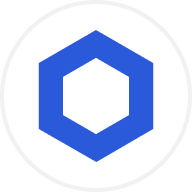Precio de Chainlink
en USDSobre Chainlink

Aviso
OKX no proporciona recomendaciones de inversión o de activos. Debes considerar cuidadosamente si el trading o el holding de activos digitales es adecuado para ti a la luz de tu situación financiera. Consulta a tu asesor legal/fiscal/profesional de inversiones para preguntas sobre tus circunstancias específicas. Para obtener más información, consulta nuestros Términos de uso y Advertencia de riesgo Al usar el sitio web de terceros ("Sitio web de terceros" o "TWP"), aceptas que el uso del TWP estará sujeto a los términos de TWP. Salvo que se indique expresamente por escrito, OKX y sus afiliados ("OKX") no están asociados de ninguna manera con el propietario u operador del TPW. Aceptas que OKX no es responsable de ninguna pérdida, daño ni cualquier otra consecuencia generada por tu uso del TPW. Ten en cuenta que usar un TWP puede generar una pérdida o reducción de tus activos. El producto puede no estar disponible en todas las jurisdicciones.
Rendimiento del precio de Chainlink
Chainlink en las noticias
El ETF de Chainlink propuesto por Bitwise ha sido listado en el sitio web de...
Chainlink, una red descentralizada de oráculos, anunció hoy su asociación con SBI Digital Markets (SBIDM),...
WisdomTree, una firma de gestión de activos, ha seleccionado a Chainlink, una red de oráculos...
Tradeweb, líder en mercados electrónicos, se ha asociado con Chainlink para hacer que los Precios...
Chainlink, un proveedor de infraestructura blockchain, hoy anunció una asociación con Chainalysis, una plataforma de...
Chainlink en las redes sociales
Guía

Crea una cuenta de OKX gratis.
Añade fondos a tu cuenta.
Elige tus criptos.
Chainlink en Academia de OKX
Preguntas frecuentes sobre Chainlink
Descubre más sobre Chainlink
Chainlink es una red oráculo descentralizada que permitecontratos inteligentes basados en blockchainpara acceder a datos fiables del mundo real almacenados fuera de la blockchain. Para ello, Chainlink recompensa a los proveedores de datos, conocidos como oráculos, por proporcionar datos precisos y valiosos a cambio deLINK, la criptomoneda ERC-20 nativa de Chainlink.
Chainlink comprende casi 1000 redes de oráculo descentralizados independientes que ofrecen datos del mercado de las criptos, tasas de FX, índices, predicciones meteorológicas, estadísticas deportivas, resultados electorales, información sobre vuelos y otra información a los contratos inteligentes en más de 12 redes de blockchain.Arbitrum,Avalanche,Ethereum,Fantom,HarmonyyPolygonson una de las cadenas de bloques admitidas por Chainlink.
Para convertirse en un oráculo en el ecosistema Chainlink, los proveedores de datos deben hacer staking primero de un número predeterminado de tokens LINK para mantener la integridad de la red. Si se descubre que los proveedores de datos pueden poner en peligro la viabilidad de la red, Chainlink reducirá su staking.
Además de ser un proveedor de datos descentralizados, Chainlink ofrece varios servicios, como una función aleatoria verificable (Verifiable Random Function, VRF), Keepers,Proof-of-Reserve (PoR), y el Protocolo de interoperabilidad cross-chain (CCIP). Los informes off-chain (OCC) de la red también permiten a los nodos proporcionar diez veces más datos a los contratos inteligentes, al tiempo que reducen los costes operativos en un 90 %.
Precio y tokenomía de LINK
El suministro de Chainlink está limitado duramente a mil millones de tokens LINK. Los inversores recibieron el 35 % de la oferta total, mientras que los operadores de nodos y las recompensas del ecosistema recibieron el 35 %. La empresa principal de Chainlink, SmartContract.com, recibió el 30 % de la oferta de LINK. Los tokens LINK entran en circulación cuando los operadores de nodos reciben LINK como recompensa, inversores que poseen LINK o proyectos que reciben LINK como adquisición o venta en el mercado abierto.
Sobre los fundadores
Chainlink fue fundada en 2017 por el emprendedor en serie Sergey Nazarov y el ingeniero de software Steve Ellis. Antes de lanzar Chainlink, Nasarov trabajó en varios proyectos centrados en la tecnología entre pares. En 2009 cofundó ExistLocal, un mercado entre pares para turismo. En ese momento, desempeñó un papel decisivo en el lanzamiento de CryptoMail, un servicio de correo electrónico totalmente descentralizado. Nazarov también colaboró con Steve Ellis para lanzar otras dos empresas en 2014, incluida SmartContract.com.
Entre los asesores técnicos de Chainlink se encuentran destacadas figuras dentro y fuera de la industria de la blockchain. Entre las personas que conforman esta lista se encuentran Eric Schmidt, antiguo director general y CEO de Google, Jeff Weiner, director general de LinkedIn, y Tom Gonser, cofundador de DocuSign. Según Crunchbase, Chainlink ha recaudado 32 millones de dólares de inversores como Fundamental Labs, Andres Schwartz y Nirvana Capital.
Destacado de Chainlink
Chainlink integra los datos meteorológicos de Google Cloud
Desde 2019, Google Cloud y Chainlink han estado trabajando juntos para permitir a Chainlink incorporar los datos de Google Cloud. Chainlink ahora ha integrado completamente los datos meteorológicos descentralizados de Google Cloud en 2021. La integración de Google Chainlink emplea un nodo oráculo, que envía continuamente datos del mundo externo a la red Chainlink. Estos datos se combinan y se hacen accesibles de forma agregada para las aplicaciones de blockchain.
Socios de Chainlink: Unescop y Unicef
Chainlink se unió a la Unesco en enero de 2021 para dar a conocer la tecnología blockchain y apoyar a los prometedores colaboradores. Después de unos meses, Chainlink anunció una asociación con el Fondo de las Naciones Unidas para financiar aplicaciones de blockchain en países en desarrollo.
Chainlink 2.0
El equipo de Chainlink reveló que planea optimizar el protocolo en abril de 2021 a través del whitepaper de Chainlink 2.0. Según el whitepaper, el siguiente conjunto de actualizaciones se centrará en habilitar un sistema más descentralizado y sin necesidad de confianza para ejecutar el protocolo Chainlink. En particular, un componente de esta estrategia pide que se establezca un mecanismo de incentivos basado en el staking. Como resultado, Chainlink puede garantizar que los operadores de nodos maliciosos sean penalizados, mientras que los proveedores de datos honestos son recompensados por implementar una economía de staking anclada por LINK.
En junio de 2022, más de un año después de publicarse esta publicación, Chainlink anunció que Chainlink 2.0 permitiría a los poseedores de LINK delegar su participación para involucrar a más personas en el proceso de validación del protocolo. Además, la actualización incluirá un avanzado sistema de seguimiento de reputación que generará indicadores de rendimiento para cada operador de nodo.








































